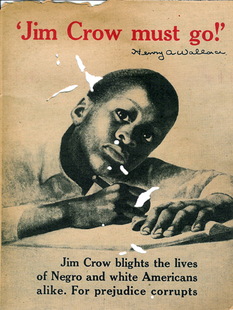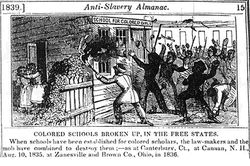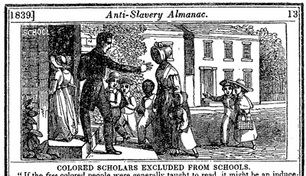What Was life like for free blacks in Antebellum America?

Propaganda against the segregation in public schools.
During the period of Antebellum America black people faced many discriminations and hardships, regardless if they were free or enslaved. Although free blacks in antebellum America had few rights and privileges their condition was not significantly better than enslaved people because of legal segregation and lack of adequate education.
In 1793 a set of laws were passed that allowed slave owners to retrieve their fugitive slaves from anywhere in America. The Fugitive Slave Laws as they became known endangered many freemen. With the law on the side of slaveholders any black could be captured and claimed as a slaveholder’s property without that person previously being the owner’s slave. Slave owners were allowed to kidnap whomever they pleased, and African Americans had no legal rights to fight against it. These laws also restricted the movement of blacks across of the nation. The 1850 Fugitive Slave Laws reinforced this fear in blacks, and revamped the legal force against them. It also held abolitionist or witnesses to the aiding/embedding of a slave accountable to the law. If they were caught helping a runaway they could also face charges.
Another political avenue that further divided free blacks, and whites in America was, the denial of freed black’s suffrage. Although in the early colonial years free, land owning, black men had the right. As year’s progress, lower southern states and some upper southern states and even some northern states, voided the land requirement and made voting only available to white men. The lower south was much harder on blacks freed or enslaved. There were a smaller percentage of freed blacks in these states; they had less of a chance gaining rights or any recognition as a citizen, or even a human. They faced constant violence and degradation, especially women, who were the constant target of sexual harassment. One-third of the black population lived in the upper south. Conditions for freed blacks were just slightly better for there, but not a lot of change; even though they were a slightly higher percentage, they still did not have full rights. Blacks were often allowed to own small plots of land that were commonly very close to the plantation, where they were born and or where their families still remained. Many even lived among slaves, in their quarters. They also held skill specific jobs. Freed African Americans faced the constant threat of being captured and reentered into slavery, even though many carried around free-papers, (documents proving their freedom) they were ignored and enslaved. In each area blacks were believed to lower property value.
In 1793 a set of laws were passed that allowed slave owners to retrieve their fugitive slaves from anywhere in America. The Fugitive Slave Laws as they became known endangered many freemen. With the law on the side of slaveholders any black could be captured and claimed as a slaveholder’s property without that person previously being the owner’s slave. Slave owners were allowed to kidnap whomever they pleased, and African Americans had no legal rights to fight against it. These laws also restricted the movement of blacks across of the nation. The 1850 Fugitive Slave Laws reinforced this fear in blacks, and revamped the legal force against them. It also held abolitionist or witnesses to the aiding/embedding of a slave accountable to the law. If they were caught helping a runaway they could also face charges.
Another political avenue that further divided free blacks, and whites in America was, the denial of freed black’s suffrage. Although in the early colonial years free, land owning, black men had the right. As year’s progress, lower southern states and some upper southern states and even some northern states, voided the land requirement and made voting only available to white men. The lower south was much harder on blacks freed or enslaved. There were a smaller percentage of freed blacks in these states; they had less of a chance gaining rights or any recognition as a citizen, or even a human. They faced constant violence and degradation, especially women, who were the constant target of sexual harassment. One-third of the black population lived in the upper south. Conditions for freed blacks were just slightly better for there, but not a lot of change; even though they were a slightly higher percentage, they still did not have full rights. Blacks were often allowed to own small plots of land that were commonly very close to the plantation, where they were born and or where their families still remained. Many even lived among slaves, in their quarters. They also held skill specific jobs. Freed African Americans faced the constant threat of being captured and reentered into slavery, even though many carried around free-papers, (documents proving their freedom) they were ignored and enslaved. In each area blacks were believed to lower property value.
Was it significantly better than life for enslaved peoples?

An African-American school being attacked by a mob.
Freed blacks in the north were assumed to be better off, but what is commonly unknown, they were discriminated against as much as blacks in the lower and upper south. They too didn’t have full rights, nor could they own land in some parts and on very rare occasions they could possibly try a case against someone. Rarely was this person white. The north was partially free it varied from state to state what rights they had and did not. It is a misconception to believe that freemen in the north were equal to whites. Many northern whites were just as prejudice towards them as southerners were. Blacks faced the same restrictions they would in the south, with the separation from public institutions. Jim Crow was a phrase first used to describe the cars blacks were allowed to ride in on the railroad, but it soon reflected the restrictions African Americans faced as a whole.
Education was a prime example of the segregation blacks faced; freed or enslaved education was a luxury. By the 1820 and 1860 schools were racially segregated leaving many African American children and some adults to be taught in dilapidated, overcrowded, rooms of churches, or houses, because they weren’t allowed to attend school with white children. White parents demanded the separation, they felt black student lacked the mental capacity, and lowered the quality of education their children would receive. There was almost nonexistent funding for black schools, which left children without adequate supplies to gain a well-rounded education. The poor pay to teachers sometimes left students without a motivated educator also lessening their learning experience. By the 1830’s most northern African Americans were in favor of integrated public education.
Antebellum America was a place of unsteady tension between blacks and whites northerners and southerners. In short freemen had a slight advantage over the enslaved because they could (in some parts), live and work where they desired. But they still faced restrictions from laws and people, which led them to restrictions from a better life. Though their freedom may have seemed like a better way of life to the enslaved people, freed blacks still had many struggles and hardships to maintain their freedom, or to even use it to their full advantage.
Education was a prime example of the segregation blacks faced; freed or enslaved education was a luxury. By the 1820 and 1860 schools were racially segregated leaving many African American children and some adults to be taught in dilapidated, overcrowded, rooms of churches, or houses, because they weren’t allowed to attend school with white children. White parents demanded the separation, they felt black student lacked the mental capacity, and lowered the quality of education their children would receive. There was almost nonexistent funding for black schools, which left children without adequate supplies to gain a well-rounded education. The poor pay to teachers sometimes left students without a motivated educator also lessening their learning experience. By the 1830’s most northern African Americans were in favor of integrated public education.
Antebellum America was a place of unsteady tension between blacks and whites northerners and southerners. In short freemen had a slight advantage over the enslaved because they could (in some parts), live and work where they desired. But they still faced restrictions from laws and people, which led them to restrictions from a better life. Though their freedom may have seemed like a better way of life to the enslaved people, freed blacks still had many struggles and hardships to maintain their freedom, or to even use it to their full advantage.
Reflection

African-Americans being excluded from a all white schools.
The topic of life for free blacks compared to the turmoil of slaves was a very interesting. It showed the dynamics that related the two groups but also what little differences that made the grass look greener on the other side. The fact that freedmen had to still fear for their freedom was also interesting, because to us freedom should be secured especially if you personally have not put yourself in a position where it might be compromised. Also the idea that African Americans as early as this time was thought everyone should have an equal education but the legal fight for it didn’t happen until years and years later.
Quote
"Beware of evil advisers who countenance the doctrines that may leave you slaves in age."
-Charles Francis Adam (1856)
-Charles Francis Adam (1856)
Bibliography
"American Anti-Slavery Society, American Anti-Slavery Almanac, for 1839." Rpt. in Division of Rare and Manuscript Collections, Cornell University Library. By Samuel J. May. New York:: S. W. Benedict, 1839,. 15. Web.
"American Anti-Slavery Society, American Anti-Slavery Almanac, for 1839." Rpt. in Division of Rare and Manuscript Collections, Cornell University Library. By Samuel J. May. New York:: S. W. Benedict, 1839,. 13. Web.
Hine, Darlen C., William C. Hine, and Stanley Harold. The African-American Odyssey. 2nd ed. Vol. 1. Pages 144, 146, 154, 314. Prentice Hall. Print.
// , Jason. "Jim Crow Image." TheDeltaBlues. Web. 03 Feb. 2011. <http://www.tdblues.com/>.
May, Samuel J. "Samuel J. May Anti-Slavery Collection." Cornell Library Windows on the Past. An Adress Delivered to The Memebers of Schools and The Citizens of Quincy. 33.Web. 03 Feb. 2011. <http://dlxs.library.cornell.edu/m/mayantislavery/>.
Creators:
J. Brown, K. Gant, F. Sloss
"American Anti-Slavery Society, American Anti-Slavery Almanac, for 1839." Rpt. in Division of Rare and Manuscript Collections, Cornell University Library. By Samuel J. May. New York:: S. W. Benedict, 1839,. 13. Web.
Hine, Darlen C., William C. Hine, and Stanley Harold. The African-American Odyssey. 2nd ed. Vol. 1. Pages 144, 146, 154, 314. Prentice Hall. Print.
// , Jason. "Jim Crow Image." TheDeltaBlues. Web. 03 Feb. 2011. <http://www.tdblues.com/>.
May, Samuel J. "Samuel J. May Anti-Slavery Collection." Cornell Library Windows on the Past. An Adress Delivered to The Memebers of Schools and The Citizens of Quincy. 33.Web. 03 Feb. 2011. <http://dlxs.library.cornell.edu/m/mayantislavery/>.
Creators:
J. Brown, K. Gant, F. Sloss
